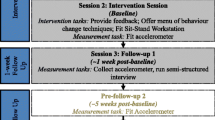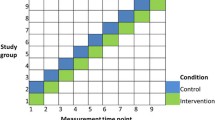Abstract
Objectives
Initiatives to reduce office-workplace sitting are proliferating, but the impact of pre-existing musculoskeletal symptoms on their effectiveness has not been determined. We assessed the influence of musculoskeletal symptoms on the outcomes of a workplace sitting intervention.
Methods
Baseline and 3-month data from a cluster-randomized controlled trial of a workplace sitting intervention (Stand Up Victoria; trial registration number ACTRN12611000742976) were used. Office workers (n = 231) from 14 work teams within one organisation were randomised (by worksite) to a multicomponent program with individual-, organisational-, and environmental-level (sit-stand workstations) change strategies; or, to a control condition (no intervention). Musculoskeletal symptoms in the low-back, upper and lower extremities (present/absent) were assessed through self-report. Linear regression models tested the moderation by baseline musculoskeletal symptoms of intervention effects on workplace sitting and standing time and on sitting and standing bout durations, assessed by the activPAL3™ activity monitor.
Results
There were significant reductions in sitting and increased standing at work (p < 0.05). However, effects varied significantly by the presence of pre-existing low-back (but not other) symptoms, with greater benefit being seen in those without symptoms. Effects on sitting time and sitting bout duration were weaker in those with low-back symptoms compared to those without by 34.6 [95% CI (0.9; 68.3)] min/8-h workday and 5.1 [95% CI (0.2; 9.9)] min, respectively. Comparable effects were seen for standing.
Conclusion
Low-back symptoms may impact on the extent to which office workers change their workplace sitting and standing time. A prudent next step to improve the effectiveness of workplace sitting-reduction initiatives such as Stand Up Victoria may be to assess and address the needs of those who displayed comparatively limited behaviour change, namely those with pre-existing low-back discomfort.
Similar content being viewed by others
References
Andersen JH, Haahr JP, Frost P (2007) Risk factors for more severe regional musculoskeletal symptoms: a two-year prospective study of a general working population. Arthritis Rheum 56(4):1355–1364
Biswas A et al (2015) Sedentary time and its association with risk for disease incidence, mortality, and hospitalization in adults: a systematic review and meta-analysis. Ann Intern Med 162(2):123–132
Chen SM, Liu MF, Cook J, Bass S, Lo SK (2009) Sedentary lifestyle as a risk factor for low back pain: a systematic review. Int Arch Occup Environ Health 82(7):797–806
Church TS et al (2011) Trends over 5 decades in U.S. occupation-related physical activity and their associations with obesity. PLoS One 6(5):e19657
Coenen P, Gilson G, Healy GN, Dunstan DW, Straker LM (2017) A qualitative review of existing national and international occupational safety and health policies relating to occupational sedentary behaviour. Appl Ergon 60:320–333
Commissaris DA et al (2014) Effects of a standing and three dynamic workstations on computer task performance and cognitive function tests. Appl Ergon 45(6):1570–1578
Dickinson CE, Campion K, Foster AF, Newman SJ, O’Rourke AM, Thomas PG (1992) Questionnaire development: an examination of the nordic musculoskeletal questionnaire. Appl Ergon 23(3):197–201
Dunstan D et al (2013) Reducing office workers’ sitting time: rationale and study design for the Stand Up Victoria cluster randomized trial. BMC Public Health 13:1057
Gilson ND, Puig-Ribera A, McKenna J, Brown WJ, Burton NW, Cooke CB (2009) Do walking strategies to increase physical activity reduce reported sitting in workplaces: a randomized control trial. Int J Behav Nutr Phys Act 6:43
Grant PM, Ryan CG, Tigbe WW, Granat MH (2006) The validation of a novel activity monitor in the measurement of posture and motion during everyday activities. Br J Sports Med 40(12):992–997
Griffiths KL, Mackey MG, Adamson BJ, Pepper KL (2012) Prevalence and risk factors for musculoskeletal symptoms with computer based work across occupations. Work 42(4):533–541
Healy GN et al (2012) Reducing prolonged sitting in the workplace (an evidence review: full report). In: Foundation VHP (ed). Melbourne, Australia
Healy GN et al (2016) A cluster RCT to reduce office workers’ sitting time: impact on activity outcomes. Med Sci Sports Exerc. doi:10.1249/MSS.0000000000000972
Kozey-Keadle S, Libertine A, Lyden K, Staudenmayer J, Freedson PS (2011) Validation of wearable monitors for assessing sedentary behavior. Med Sci Sports Exerc 43(8):1561–1567
Lerner D, Amick BC, Rogers WH, Malspeis S, Bungay K, Cynn D (2001) The work limitations questionnaire. Med Care 39(1):72–85
Lyden K, Kozey Keadle SL, Staudenmayer JW, Freedson PS (2012) Validity of two wearable monitors to estimate breaks from sedentary time. Med Sci Sports Exerc 44(11):2243–2252
Mathiassen SE (2006) Diversity and variation in biomechanical exposure: what is it, and why would we like to know? Appl Ergon 37(4):419–427
Neuhaus M et al (2014a) Reducing occupational sedentary time: a systematic review and meta-analysis of evidence on activity-permissive workstations. Obes Rev 15(10):822–838
Neuhaus M et al (2014b) Iterative development of Stand Up Australia: a multi-component intervention to reduce workplace sitting. Int J Behav Nutr Phys Act 11:21
O’Sullivan P (2005) Diagnosis and classification of chronic low back pain disorders: maladaptive movement and motor control impairments as underlying mechanism. Man Ther 10(4):242–255
Palmer K, Smith G, Kellingray S, Cooper C (1999) Repeatability and validity of an upper limb and neck discomfort questionnaire: the utility of the standardized Nordic questionnaire. Occup Med 49(3):171–175
Parry S, Straker L (2013) The contribution of office work to sedentary behaviour associated risk. BMC Public Health 13:296
Parry S, Straker L, Gilson ND, Smith AJ (2013) Participatory workplace interventions can reduce sedentary time for office workers–a randomised controlled trial. PLoS One 8(11):e78957
Prince SA, Saunders TJ, Gresty K, Reid RD (2014) A comparison of the effectiveness of physical activity and sedentary behaviour interventions in reducing sedentary time in adults: a systematic review and meta-analysis of controlled trials. Obes Rev 15(11):905–919
Roaldsen KS, Elfving B, Stanghelle JK, Talme T, Mattsson E (2009) Fear-avoidance beliefs and pain as predictors for low physical activity in patients with leg ulcer. Physiother Res Int 14(3):167–180
Ryan CG, Grant PM, Tigbe WW, Granat MH (2006) The validity and reliability of a novel activity monitor as a measure of walking. Br J Sports Med 40(9):779–784
Schmid D, Leitzmann MF (2014) Television viewing and time spent sedentary in relation to cancer risk: a meta-analysis. J Natl Cancer Inst 106(7):dju098
Shikiar R, Halpern MT, Rentz AM, Khan ZM (2004) Development of the Health and Work Questionnaire (HWQ): an instrument for assessing workplace productivity in relation to worker health. Work 22(3):219–229
Shrestha N, Kukkonen-Harjula KT, Verbeek JH, Ijaz S, Hermans V, Bhaumik S (2016) Workplace interventions for reducing sitting at work. Cochrane Database Syst Rev 3:CD010912
Stephens SK et al (2014) Intervening to reduce workplace sitting time: how and when do changes to sitting time occur? Br J Sports Med 48(13):1037–1042
Straker L, Healy GN, Atherton R, Dunstan DW (2014) Excessive occupational sitting is not a “safe system of work”: time for doctors to get chatting with patients. Med J Aust 201(3):138–140
Straker L, Coenen P, Dunstan DW, Gilson N, Healy GN (2016) Sedentary work—evidence on an emergent work health and safety issue. Safe Work Australia, Canberra
Teychenne M, Costigan SA, Parker K (2015) The association between sedentary behaviour and risk of anxiety: a systematic review. BMC Public Health 15:513
Thorp AA et al (2012) Prolonged sedentary time and physical activity in workplace and non-work contexts: a cross-sectional study of office, customer service and call centre employees. Int J Behav Nutr Phys Act 9:128
Vanhees L et al (2012) Importance of characteristics and modalities of physical activity and exercise in the management of cardiovascular health in individuals with cardiovascular disease (Part III). Eur J Prev Cardiol 19(6):1333–1356
Waters TR, Dick RB (2014) Evidence of health risks associated with prolonged standing at work and intervention effectiveness. Rehabil Nurs 40(3):148–165
Zhai L, Zhang Y, Zhang D (2014) Sedentary behaviour and the risk of depression: a meta-analysis. Br J Sports Med. doi:10.1136/bjsports-2014-093613
Zhang D, Jiang W, Wu Y, Jiang X (2014) Re: television viewing and time spent sedentary in relation to cancer risk: a meta-analysis. J Natl Cancer Inst 106(11):dju303
Acknowledgements
The Stand Up Victoria study was funded by a National Health and Medical Research Council (NHMRC) Project Grant (#1002706), project funding from the Victorian Health Promotion Foundation’s Creating Healthy Workplaces program and, and by the Victorian Government’s Operational Infrastructure Support Program. GH was supported by a NHMRC Career Development Fellowship (NHMRC #108029). EW was supported by a NHMRC Centre for Research Excellence Grant on Sitting Time and Chronic Disease Prevention–Measurement, Mechanisms and Interventions (#1057608). DD was supported by a NHMRC Senior Research Fellowship (NHMRC #1078360). NO was supported by a NHMRC Program Grant (NHMRC #569940), a NHMRC Senior Principal Research Fellowship (NHMRC #1003960), a NHMRC Centre for Research Excellence Grant (NHMRC #1057608) and by the Victorian Government’s Operational Infrastructure Support Program. MM was supported by a NHMRC Centre for Research Excellence in Obesity Policy and Food Systems (NHMRC #1041020). EE is supported by a NHMRC Senior Research Fellowship (NHMRC #511001). LS was supported by a NHMRC Senior Research Fellowship (NHMRC #1019980). We acknowledge and thank all the participants of the Stand Up Victoria study, as well as other staff involved at the Department of Human Services.
Author information
Authors and Affiliations
Corresponding author
Ethics declarations
Conflict of interest
The authors declare that they have no conflict of interest.
Electronic supplementary material
Below is the link to the electronic supplementary material.
Rights and permissions
About this article
Cite this article
Coenen, P., Healy, G.N., Winkler, E.A.H. et al. Pre-existing low-back symptoms impact adversely on sitting time reduction in office workers. Int Arch Occup Environ Health 90, 609–618 (2017). https://doi.org/10.1007/s00420-017-1223-1
Received:
Accepted:
Published:
Issue Date:
DOI: https://doi.org/10.1007/s00420-017-1223-1




